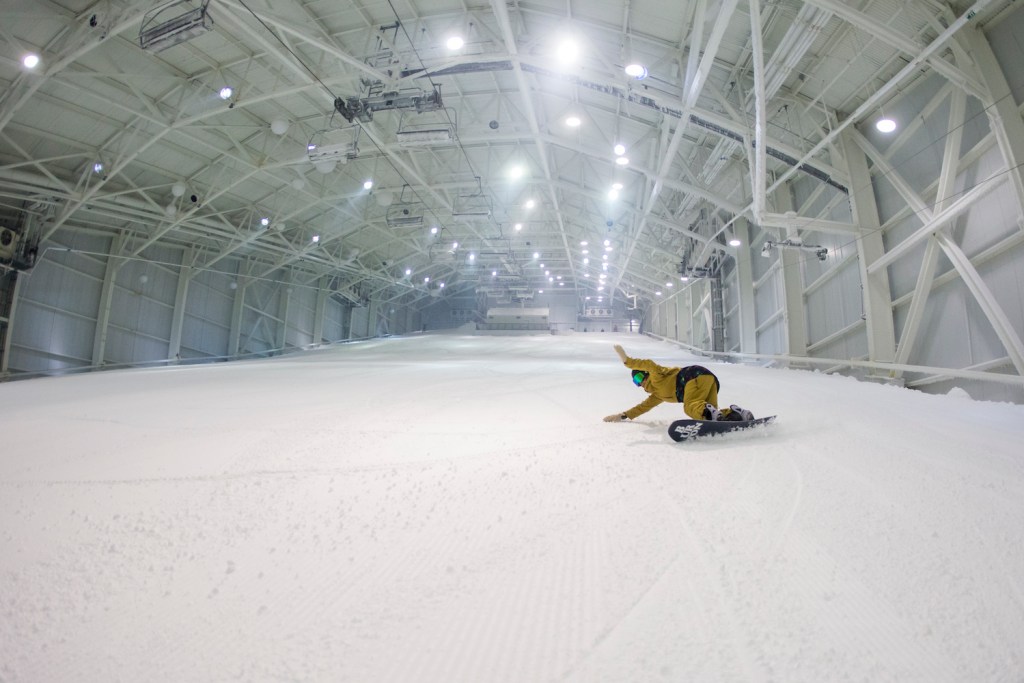This op-ed represents the opinions of Heather Hansman.
I’m not a fiction writer, but if I were to write a novel about the dystopian future I might set it in a once-abandoned mall, smack in the middle of a former swamp in suburban New Jersey. I would call it American Dream, and inside, there would be an artificial mimic of the natural world, a human-made mountain in a virtual winter.
It turns out, my dystopian fantasy already exists. It’s called Big Snow American Dream, and it opened last December on a side of the New Jersey Turnpike, inside the eponymous American Dream mall, a 3-million-square-foot megamall, which is also home to a theme park and a department store that just sells candy.
Big Snow has three ski trails and a terrain park in a frigid 16-story building. The hill drops 160 feet, at a maximum slope angle of 26 degrees. Huge air conditioners keep it 28 degrees inside, while fan guns produce snow.
Yes, it’s an artificial pay-to-play icebox inside a giant temple of commerce and commercialism, but it’s also more complicated than that. Skiing inside a mall might be an erosion of nature, but it’s also an entry point to a sport that’s historically been an expensive playground for privileged people. And in the world we live in—which might be trending toward dystopia anyway—I’m not sure that’s a bad thing.
“The two biggest barriers to getting people to ski and snowboard is that it’s hard to get to the mountain and it’s super expensive,” said Joe Hession, CEO of Snow Operating, which runs Big Snow. He said that in selecting a location that’s accessible by public transit, they’re working to remove the location barrier to skiing. They’ve also made it more affordable. A two-hour block of skiing with rental gear (including outerwear) and a lesson costs $65. Not cheap, but significantly less than what the same New Yorker might spend to go to a real ski hill upstate.
Supporters of the place say it’s democratizing an expensive, elite sport. It’s like what climbing gyms did for rock climbing. Sure, it’s not the same as digging your fingers into outdoor granite, but you can take a bus there.
Opponents, like the New Jersey chapter of the Sierra Club, have come out against Big Snow for a range of environmental concerns, from traffic to government subsidies. Critics are skeptical about the viability of a mega mall that has cost upwards of $5 billion to construct in an era when malls are dying. They say skiing indoors is going through the motions, but it’s not the same experience as being on a real mountain. Slipping downhill in a 16-story ice chest is slightly better than virtual reality, but it’s still artificial.
This gets into a complicated question about what we love about outdoor sports, and skiing in particular. Is it moving our bodies? The connection to nature? Is it the rush of adrenaline, skill building, speed? You can get some of those things at an indoor ski hill, but definitely not all of them.

It may not be a traditional mountain experience, but a mall in New Jersey is helping to give people the experience of sliding down snow. (Photo Courtesy of Big Snow)
But saying that something like Big Snow is objectively bad feels like an elitist point of view. I’m someone who had the good fortune of being introduced to skiing at a young age, by a family who supported the habit. I know the thrill of going downhill fast and the thrall of being in the mountains all day. But I’m lucky. That access to the mountains is a privilege. And the access is getting even harder as small local ski areas struggle to stay open in the face of climate change and corporate consolidation.
Part of the problem with judging indoor skiing is that we’re living in a dystopian future already. The problem isn’t Big Snow American Dream. It’s the American dream of the world around it, and the narrow pathways that exist to getting outside. Lots of people, especially those close to major urban centers like New York City, don’t have easy access to traditional outdoor pursuits. Plus, skiing is prohibitively expensive. None of it is easy.
In its best version of itself, Big Snow is a relatively inexpensive, easy-to-access, low-stakes way to get people moving their bodies downhill, feeling the rush of exercise and gravity. At its worst, it’s a totally removed experience, the faint, diluted memory of winter and nature as climate change happens around us. A pale specter of the natural world.
Both of those can be true, so maybe this is a ski hill for our times. It’s good and it’s bad, but the future is a complicated place, and it has to hold both of those visions.
